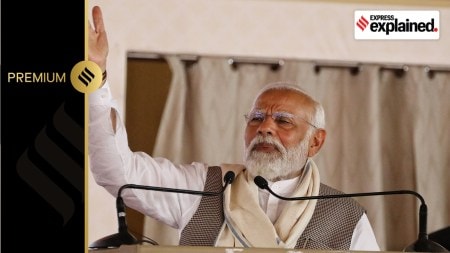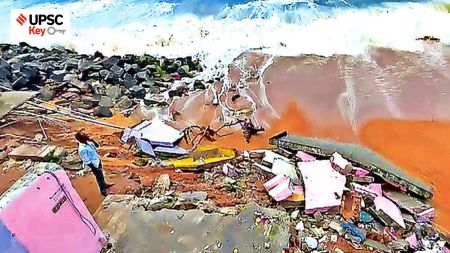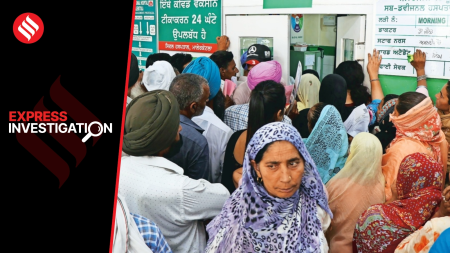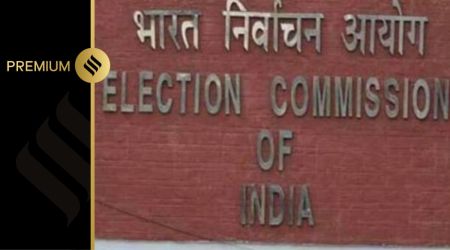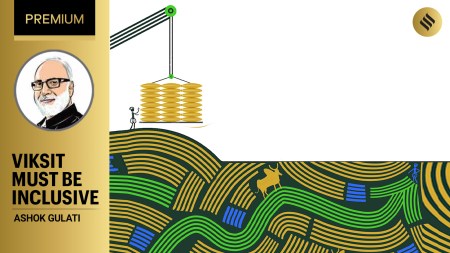In Rohti Channa village, nestled in the former princely state of Nabha in Punjab’s Patiala district, a seemingly tranquil row of houses along the Nabha-Bhadson road conceals a truth — as much disquieting as it is new.
Over the past year, 14 residents of this village have been booked in cases filed under the Narcotic Drugs and Psychotropic Substances (NDPS) Act. Certainly, not unusual in a state where NDPS cases crowd prisons and top national crime charts. Where, as per the latest report of the National Crime Records Bureau released this month, the state topped the nationwide list in cases pertaining to possession of drugs for trafficking in 2022.
But, what makes this set of 14 special is that half of them are women.
There’s Priyanka, a 19-year-old with a ponytail, arrested last June, allegedly with 875 ‘intoxicating’ pills. Her mother and sister also faced two cases under the Act in the past. Her neighbour Bimla, a matriarch presiding over a well-appointed house frequented by local political leaders, is among those booked for drug dealing last year. Three other women were allegedly caught with heroin ranging from 4.5 grams to 60 grams, while two were booked for peddling ‘nasheeli tablets’, and one for selling 10 kilos of poppy husk.
These women are a new chapter in Punjab’s drug addiction story that has for long been overwhelmingly dominated by men, young and old, both as users and peddlers. But as an investigation by The Indian Express reveals, it’s now touching women, too, in many ways similar to men — but with a social impact that has many more dimensions and frames a new challenge in the state’s war against drugs.

 While 2017 and 2018 saw less than 900 NDPS cases against women, this figure spiked to over 1,233 in 2019. It dropped in 2020, a pandemic year, but has been steadily rising since
While 2017 and 2018 saw less than 900 NDPS cases against women, this figure spiked to over 1,233 in 2019. It dropped in 2020, a pandemic year, but has been steadily rising since
An analysis by The Indian Express of all 11,156 FIRs filed under the NDPS Act by the Punjab Police between April 1, 2022 and February 28, 2023 — the period for which the state police presented a summary of their anti-drug efforts to the Assembly — shows that women now account for over 10% of the cases.
Indeed, these numbers have been rising steadily — while 2017 and 2018 saw less than 900 NDPS cases against women, this figure spiked to over 1,233 in 2019. It dropped in 2020, a pandemic year, but has been steadily rising since (see box).
Patiala district takes the lead with 116 FIRs against women, followed by Kapurthala and Ludhiana, with 63 FIRs each, and SBS Nagar with 56 cases. An investigation of the FIRs where women are named reveals telling patterns:
📌 Most women peddlers are either from rural areas or bastis/ EWS colonies in the cities.
📌 Of the 1,533 women who were arrested in connection with the FIRs, an overwhelming 1,408 are married.
n In terms of Punjab’s four major regions, the most number of cases (731) are from Malwa, which is also the biggest belt with 66 Assembly seats. This is followed by Doaba (303 cases), Majha (131) and Poadh (26). This suggests a direct link between poverty and drug peddling, as parts of Malwa score low on social indices. A study on farm suicides in Punjab from 2000 to 2013, conducted by a professor at Punjabi University, had found that 97% of these suicides occurred in Malwa.
Punjab police chief, DGP Gaurav Yadav, acknowledged they have observed a rise in the number of women drug dealers, especially among denotified tribes. Often during raids, the men flee, leaving the women with the contraband, says Yadav, adding, “Women are taking the lead in every field; this is another one.’’
All in the family
Police officers say drug peddling has transformed into a family business in many parts of the state, with women taking on more prominent roles. They operate the trade when men are apprehended or if they die prematurely. “Many have become key figures in the trade, we have evidence linking them to this activity,” says SHO Sukhvinder Kumar from Ganna Pind in Phillaur, which is notorious for drug peddlers.
Visits to various villages corroborates this trend. In Ganna Pind, Gyano, a matriarch of 56, was booked in an NDPS case along with 11 family members — including her four sisters and 20-year-old granddaughter — during a police raid in October 2022. They all live in a lane where Gyano’s house is the most imposing. Returning home after three months in Kapurthala jail, she accuses the police of targeting her because she belongs to the Sansi community.
Gulzari Lal, who has been the sarpanch of Ganna Pind for 20 years, says that the village has acquired a negative image due to a handful of “blackiye” (those involved in the drug trade), many of whom have now fled abroad. Gyano’s son, now in the UK, is allegedly among them.
In many villages plagued by addiction, poverty is the primary force driving women into the drug trade. In Talwandi Kalan Ladhowal village in Ludhiana district, for instance, Kamla, a 24-year-old with disabilities, is facing three drug-related cases. Her sister says that Kamla, a matriculate, was compelled to enter the trade following the deaths of male family members. Now, she has taken a loan to cover her legal fees.
Numerous women in this village are entangled in NDPS cases.
Darbara Singh, a former panch, says, “Out of approximately 500 homes in our village, at least 100 have NDPS cases.” He attributes this to a lack of job opportunities and the vacuum created by the ban on sand mining on the Satluj riverbed. Inspector Jagdev Singh Dhaliwal, in charge of the local police station, points out that almost every other household is involved in drugs, with women playing a significant role.
In village after village, shattered homes
NDPS cases put accused women and their families on the police radar, often indefinitely. Kulwinder Kaur, a 44-year-old from Chaunta village in Ludhiana, who has mobility issues due to diabetes, attests to this. Sitting in a dimly lit room with her son, Jasbir Singh, 24, whose limbs bear the scars of injection marks, and her husband Kulwant Singh, who claims to have been acquitted in two of his three NDPS cases, she claims they no longer sell drugs.
“But last year, I was arrested from this very room and assaulted on the way to the police station. Later, I learned they put a recovery of 55 grams of heroin on me,” she claims. With their younger son, Sukhwinder Singh, making a living as a DJ, the couple says they want to break free from this vicious cycle.
Regardless of the quantity seized, an NDPS case means time in jail, legal expenses, and little hope of finding work. Balveer Kaur, a 55-year-old confectionery shop owner in Chaunta village and mother of five daughters and a son, explains that she has mortgaged their one-acre land for Rs 1 lakh to cover the legal fees and medical expenses of her only son, Narinder Singh, 32. He is a drug addict who was also incarcerated for allegedly selling drugs and is currently fighting for his life in a hospital.
The most significant toll that NDPS cases against women take is on their children. In Badshapur village in Kapurthala district, a teenage girl was arrested in September after a video of her selling drugs went viral. The Indian Express visited her home to find that her mother was already in jail for alleged drug peddling. Villagers say her father, a habitual offender, was recently released on bail. At her house, her four siblings, aged between 13 and four, were huddled on the roof as they awaited their father’s return. With parents in and out of prison, their education is the biggest casualty.
At Ganna Pind near Phillaur, the 20-year-old booked in an NDPS case along with her grandmother last October says she was thrown out of school after the case. In Mansa district’s Bhikhi Ward No. 2, siblings Diljani Singh, an MBA, and Rani Devi, a postgraduate, teach children in their locality to make a living while their mother, Bholi Kaur, remains in Bathinda jail. She was arrested on December 21, 2022, after police allegedly recovered 2,000 intoxicant pills from her possession. Diljani Singh claims, “There were cases against her earlier too, but she was acquitted. In this case, the police recovered intoxicant tablets from a vacant plot that belongs to us. They pinned that recovery on my mother.” He points out that even though they teach and his younger brother Harpreet is preparing for competitive exams, the locals continue to stigmatise them because of the NDPS case against their mother. “What is our fault,” he asks.
In Rohti Chhanna village, Priyanka, 19, says she once aspired to join the police, but now her sole desire is to be acquitted. Her neighbour laments that this case has cast a permanent shadow on her future. “It’s a blot forever. Who will marry her?”
Easy money, hard choices
Other factors such as the lure of easy money or the need to fund one’s addiction also propel some women towards peddling drugs.
The trade is lucrative, with a gram of heroin, or chitta as it is called in local parlance, fetching between Rs 1,000 and Rs 5,000. In villages The Indian Express visited, the accused are feared by the locals. At a village near Phillaur, for instance, the sarpanch first admitted to a middle-aged woman being a repeat offender, but changed his tune and began to blame the police in her presence. At another village in Ludhiana district, neighbours pointed out the house of the accused but refused to go any further.
Rupinder Kaur Sra, Assistant Commissioner of Police, Ludhiana City, says the proliferation of women in the trade varies from one district to the other. “We don’t have many cases, but we find instances of drug dealing among commercial sex workers. Then there are women who, unaware of the consequences, get co-opted by their boyfriends into stocking or safekeeping drugs. We recently caught a woman dhaba owner with a large quantity of contraband that had been kept by a male acquaintance.’’
Dr Sandeep Bhola, who has been running a de-addiction centre in Kapurthala for over a decade, says the nature of their work forces sex workers to take refuge in drugs and often they start peddling to fund their habit. “Commercial sex work, drug use and peddling go hand in hand. In the past, brothels used to keep alcohol; now it’s drugs,” says Dr Bhola.
Another factor, says ACP Rupinder, is the temptation to get rich quick. In August this year, a singer named Pammi was arrested in Samrala near Ludhiana for allegedly selling drugs to a youth who overdosed and died. Police claim Pammi was struggling in her career and resorted to drug dealing to make a living.
The increasing number of female drug peddlers is directly related to the rise in the number of female drug users. The Navjeevan Kendra (de-addiction centre) at Ludhiana Civil Hospital has witnessed the number of female addicts nearly double from 26 in 2018 to 49 in 2022. Dr Bhola says that many women trapped in addiction turn to this trade to fund their supply of intoxicants.
A senior police officer says that women are also considered relatively safe drug carriers since they are less likely to be frisked, and can use public transport and inconspicuous methods to transport drugs.
Prof Pam Rajput of the International Center for Research on Women, who visited Ludhiana prison in 2015 for her research, sees a glimmer of hope in all-woman anti-drug committees formed in some Malwa villages: “Perhaps they can initiate the process of rehabilitating and reintegrating these women into village society. That would be a good first step.”



